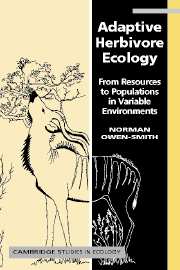Book contents
- Frontmatter
- Contents
- Acknowledgements
- Acronym and symbol conventions
- 1 Conceptual origins : variability in time and space
- 2 Consumer–resource models : theory and formulation
- 3 Resource abundance : intake response and time frames
- 4 Resource distribution : patch scales and depletion
- 5 Resource quality : nutritional gain and diet choice
- 6 Resource constraints : physiological capacities and costs
- 7 Resource allocation : growth, storage and reproduction
- 8 Resource production : regeneration and attrition
- 9 Resource competition : exploitation and density dependence
- 10 Resource-dependent mortality : nutrition, predation and demography
- 11 Habitat suitability : resource components and stocking densities
- 12 Resource partitioning : competition and coexistence
- 13 Population dynamics : resource basis for instability
- 14 An adaptive resource ecology : foundation and prospects
- References
- Index
10 - Resource-dependent mortality : nutrition, predation and demography
Published online by Cambridge University Press: 04 February 2011
- Frontmatter
- Contents
- Acknowledgements
- Acronym and symbol conventions
- 1 Conceptual origins : variability in time and space
- 2 Consumer–resource models : theory and formulation
- 3 Resource abundance : intake response and time frames
- 4 Resource distribution : patch scales and depletion
- 5 Resource quality : nutritional gain and diet choice
- 6 Resource constraints : physiological capacities and costs
- 7 Resource allocation : growth, storage and reproduction
- 8 Resource production : regeneration and attrition
- 9 Resource competition : exploitation and density dependence
- 10 Resource-dependent mortality : nutrition, predation and demography
- 11 Habitat suitability : resource components and stocking densities
- 12 Resource partitioning : competition and coexistence
- 13 Population dynamics : resource basis for instability
- 14 An adaptive resource ecology : foundation and prospects
- References
- Index
Summary
Losses in population biomass through mortality are the integrated outcome of many influences. Resource deficiencies can eventually deplete body reserves to critical levels of malnutrition, but only rarely can deaths be ascribed simply to starvation, at least for wild herbivores. Extreme weather heightens metabolic costs and restricts foraging activity, draining body reserves towards critical levels. Animals that are weakened through food shortfalls become more susceptible to being killed by predators. Malnourished animals are also more vulnerable to parasite and disease infestations, amplifying their susceptibility to predation (Sinclair 1977; White 1983). Food shortages cause animals to spend more time foraging, raising physiological expenditures and increasing exposure to predation and other sources of accidental death. Risk of predation affects the habitats that can be exploited securely, exacerbating food limitations (McNamara and Houston 1987b; Sinclair and Arcese 1995). Where surface water is a limitation, animals must concentrate their movements around drinking points, where predators lie in wait. Social strife over inadequate resources may lead directly to mortality, or to injuries pre-disposing animals to other sources of mortality.
Susceptibility to predation depends on the types of predator present and their hunting methods. Adaptively foraging predators should preferentially seek those prey that are malnourished and hence most easily captured and killed. Nevertheless, healthy animals may sometimes have the misfortune to become victims of predators lying in ambush.
- Type
- Chapter
- Information
- Adaptive Herbivore EcologyFrom Resources to Populations in Variable Environments, pp. 205 - 231Publisher: Cambridge University PressPrint publication year: 2002
- 1
- Cited by



